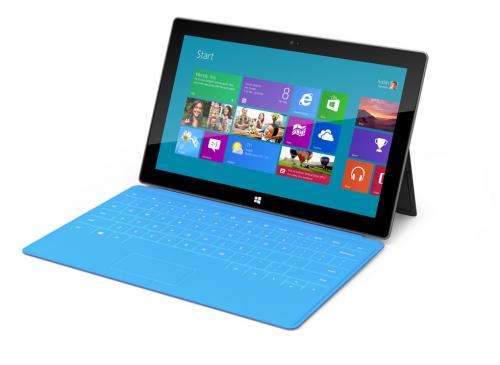Review: Microsoft's Surface tablet no iPad, but better than other rivals

I found a lot to like about Microsoft's new Surface tablet. It's generally a pleasure to use. It has innovative features. And it appears to be well-built. For Microsoft's first effort at designing a mass-market computing device, it's a remarkable achievement, and it rates at or very near the top of the 10-inch tablets that compete with Apple's iPad. It's also a much easier device to understand and use than rival tablets based on Android, and unlike those tablets, it runs Office.
But as might be expected of a first-generation gadget, it also has numerous shortcomings, and because of those, I can't recommend it over the iPad. For the same $500 base price, Apple's tablet is simply better.
At first glance, the Surface looks unremarkable. It's a black slate with a glass screen, much like many of the other tablets on the market. It has a thin case with sharp edges that looks more like a utilitarian office device than something that will excite design fetishists.
But look more closely and you'll find some nice features. Unlike many of the iPad's competitors, its case is made of magnesium, not plastic, so it feels solid. It has a unique kickstand that folds out of its back, allowing you to prop it up on a table. And it has a full-size USB port and an SD card slot, allowing users to transfer files from external drives and cards.
For its new tablet effort, Microsoft designed a version of its Windows 8 operating system to run on ARM processors, the low-power chips that underlie the iPad and nearly all other competing tablets. Thanks to its ARM chip, the Surface is as thin as the big iPad and only slightly heavier. And like the iPad, it's ultraquiet, because it doesn't have a fan.
The new version of the operating system, dubbed Windows RT, looks a lot like the versions of Windows 8 that will run on traditional PCs. It has the same "Metro" start screen with "live" application tiles that offer up-to-date information, including the current weather and snippets from your latest email messages. And it has a version of the traditional Windows desktop.
I'm not a fan of the Metro start screen on traditional PCs. But the interface, which you navigate by swiping, tapping and pinching, was made for a touch-screen device like this. Some of the gestures take getting used to, but for the most part interacting with Metro is natural and easy.
One compelling feature in the Metro interface is the ability to split the screen between two applications. So, for example, you can play "Cut the Rope" while continuing to monitor your email. It's not the same thing as actually having windowed applications, but I'm not sure you need that feature on a tablet, and the screen-split feature is one you don't get on the iPad or on the typical Android tablet.
Another cool feature about Surface is that unlike the iPad, it supports multiple users. So you and your family members can share the device without having access to each other's email.
The Surface comes with a nice collection of built-in Metro apps, including a photo gallery, a maps application, email and calendar programs and different news readers. But what is likely to be the most attractive to Windows users is that Surface ships with versions of some of the core Office programs, including Word and Excel.
Those Office programs look and work just like the Office applications that run under traditional Windows. In other words, Microsoft hasn't redesigned those applications, so you can easily interact with them on a touch screen. Fortunately, the company is offering covers for the Surface that include keyboards and trackpads to navigate the desktop and the Office programs more easily.
For all that there is to like about Surface, though, it does have several notable shortcomings. Its screen resolution is significantly less than that on the new iPad.
Similarly, its cameras are lower resolution than the ones on the iPad, so the pictures you take with it will be noticeably fuzzier. And the Surface lacks both an intelligent assistant feature like Siri and the ability to transcribe speech to text.
But its biggest shortcoming is the number and range of applications available for it. Although the Surface runs Windows, it won't run any traditional Windows programs other than ones it comes with, and even among those, it's missing Outlook. The only programs you can add to the Surface are those designed for its new Metro interface and offered through Microsoft's new Windows Store - and that offering is relatively slim right now.
So, the Surface is a compelling tablet with a lot of potential, but unless you're dead-set against an iPad, it doesn't yet measure up.
——
MICROSOFT SURFACE TABLET:
-Troy's rating: 7.0 (out of 10)
-Likes: Solid magnesium case, new interface easy to use on a touch screen, ability to split screen between two apps, built-in Office applications, clever kickstand
-Dislikes: Relatively low-resolution screen, low-resolution cameras, desktop interface and programs difficult to navigate and use via touch screen, can't run older Windows programs, Office suite lacks Outlook, relatively few apps in Windows app store, no option for version with cellular data radios
-Specs: Nvidia quad-core processor; 10.6-inch 1366-by-768 display, 720p front and rear cameras
-Price: $500 for 32GB model, $600 for 32GB model with touch keyboard cover; $700 for 64GB model with keyboard cover
-On the Web: microsoft.com
More information: Troy Wolverton is a technology columnist for the San Jose Mercury News.
(c)2012 San Jose Mercury News (San Jose, Calif.)
Distributed by MCT Information Services



















